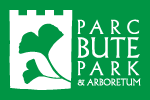Ginkgo avenue, Bute Park
Press play for RNIB audio presentation
Or, download mp3 (1.29MB)
An unusual avenue of ginkgo biloba trees leads away from you at this location in Bute Park (stand with your back to the castle and look north). The trees flank the driveway between the castle’s north entrance and the Castle Mews buildings, which you can see at the far end of the avenue.
Ginkgo is one of the oldest types of tree in existence – fossils of it dating back about 200 million years have been found in its native China. Chinese monks cultivated it for centuries before people starting planting it in European gardens in the 18th century. One of its chief attractions is the intense burst of yellow when the leaves turn in autumn.
A less attractive feature is the smell of the fruit that surrounds the seeds produced by female trees in autumn (yes, the trees have individual gender!). The ripe fruits are round, light yellow/brown in colour, and smell like rancid butter or vomit because of the type of acid they contain. Hence the ginkgo is nicknamed the ‘smelly tree’!

Avenue of Ginkgo trees, view looking south
An avenue of trees was planted along this driveway by 1880. Originally there were two rows of trees each side, later reduced to one row. When those trees needed replacing in the 1950s, Bill Nelmes, the council’s chief parks officer, chose ginkgo. He took a keen interest in botany, and even planted ginkgo trees along some of Cardiff’s suburban streets.
If you’re visiting the park in spring, summer or autumn, take a close look at the ginkgo’s leaves. They have a distinctive shape. If you’re visiting in winter, take a close look at the Bute Park logo at the top of this page – it features a pair of ginkgo leaves!
Construction of the Castle Mews buildings began in 1874, to accommodate the Bute family’s horses and carriages. Later it provided living quarters for Bute estate workers, who transferred with the park to the council in 1947. The council also used the buildings as a base for other activities and equipment. The buildings were in poor repair by the 1980s, when they were leased to the Royal Welsh College of Music and Drama. The college invested heavily in restoring the mews as an annexe to its main buildings, just to the north of the mews.
Thanks to RNIB for the audio presentation of this page
| To continue the Bute Park tour, keep walking east to the castle’s North Gate, where you’ll find the QR code on the gate railings |


